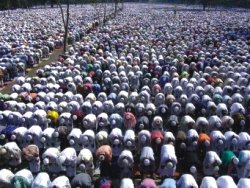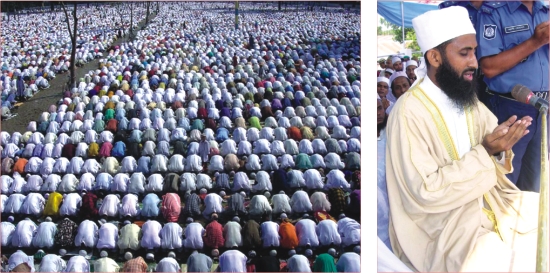| Cover Story
From Kishoreganj
Sholakia Eidgah
Moklesur Rahman Liton
 The Eid congregation of last week at the Sholakia Eidgah situated at the Kishoreganj town, was the 179th Eid congregation at this Eidgah. Eid congregation at this Eidgah is believed to be the largest in the sub-continent as over three lac (300000) pilgrims come here to offer their Eid payers every year. Pilgrims from India, Pakistan and from almost all parts of the country start arriving at the town about two to three days ahead of Eid to attend the prayer congregation at the Sholakia Eidgah. This congregation usually takes place only during the Eid-ul- Fitr. The Eid congregation of last week at the Sholakia Eidgah situated at the Kishoreganj town, was the 179th Eid congregation at this Eidgah. Eid congregation at this Eidgah is believed to be the largest in the sub-continent as over three lac (300000) pilgrims come here to offer their Eid payers every year. Pilgrims from India, Pakistan and from almost all parts of the country start arriving at the town about two to three days ahead of Eid to attend the prayer congregation at the Sholakia Eidgah. This congregation usually takes place only during the Eid-ul- Fitr.
The first Eid congregation on this ground was held in 1828 when a local Dewan called Sayeed Ahmed (R.) of Haibatnagar Dewan Bari in the town conducted the Eid prayer at one of the fields of his own Talok. This later became known in history as the Sholakia Eidgah. The elders of the area say that the area was named after the Eidgah as there was once a congregation of 1 lac 25 thousand people at the Eidgah. The name Sholakia comes from Shoa Lac meaning one lac twenty-five thousand being the number of people that had come to offer their Eid-ul-fitr prayers at the Eidgah. The surrounding area was also named Sholakia afterwards. Later another Dewan called Mannan Dad Kha who also happened to be a descendent of Mas - Nad-E-Ala Isa Kha gave 4.35 acres of land for the Eidgah in 1950. However, according to sources, the Sholakia Eidgah now has about 7 acres of land.
 The Eidgha stands on the bank of river Narosunda and is known throughout the continent not for its architectural specialty but for the large number of devotees who come here every year for saying their Eid prayers.There is a small two-storied primary school at the west end of the Eidgah. The school building does not have any feature of Islamic architectural design. The Eidgah is fenced with a chest-high boundary wall which has several gaps to allow people in and out, but there are no gates or shutters. The Eidgha stands on the bank of river Narosunda and is known throughout the continent not for its architectural specialty but for the large number of devotees who come here every year for saying their Eid prayers.There is a small two-storied primary school at the west end of the Eidgah. The school building does not have any feature of Islamic architectural design. The Eidgah is fenced with a chest-high boundary wall which has several gaps to allow people in and out, but there are no gates or shutters.
There are about 265 rows, each of which can accommodate five hundred pilgrims at the Eidgah. So the capacity of the entire field is about 1,32,500 pilgrims. However, more than three lac pilgrims say their prayers here making use of the nearby roads, open spaces and courtyards of surrounding houses.
Sholakia Eidgah has an executive committee of 51 members with the Deputy Commissioner (DC) as the president of the committee. All arrangements for the Eid prayer are undertaken by the committee but the arrangements are generally very simple as pilgrims prefer to offer prayers under an open sky be it rain or sunshine. Only the ruling party ministers, MPs, leaders and some selected elites of the town use the two-storied Mimbor building which is used by the Imam of the Eidgha. The Mimbor can accommodate about 500 pilgrims.
Tight security measures are taken from at least three days prior to the Eid day congregation. The district police administration deploys huge number of police officers most of whom use metal detectors, mine detectors and close circuit cameras. Several medical teams and fire brigades are also kept alert during Eid prayer.

Mofti Abul Khair Md. Saifullah has been conducting the eid prayers since 2004. Before him, his father, Principal Mofti Abul Khair Md. Nurullah had conducted these prayers for 28 years (1975 to 2003).
The Publicity Secretary of the Eidgah committee, Chowdhury Moniruzzaman Khan Sohel says, “It is our bad lack that we could not adorn Sholakia Eidgha according to its rank. Many pilgrims coming from distant places have to stay and sleep in the field due to lack of space for shelter. There is also no bridge on the river.” He says that Narosunda is a dead river and people usually cross it by using make-shift bridges made of bamboo. This has sometimes caused accidents even on the Eid day. says, “It is our bad lack that we could not adorn Sholakia Eidgha according to its rank. Many pilgrims coming from distant places have to stay and sleep in the field due to lack of space for shelter. There is also no bridge on the river.” He says that Narosunda is a dead river and people usually cross it by using make-shift bridges made of bamboo. This has sometimes caused accidents even on the Eid day.
Some of the locals happen to think that Sholakia Eidgha can be a totally self-reliant Eidgah as a huge amount of money is collected from the pilgrims every year. Proper management and right decisions can make it a standard Eidgah. Some local people say that the Eidgah has been neglected for years and that whatever little work has been done was very unplanned.
An Eid fair is held at Sholakia Eidgah on every Eid day after the prayers. Toys, wooden home appliances, floor mats and traditional local sweetmeats are sold and bought in abundace at the fair. Local people, irrespective of their class or religion, gather at the Eid fair. This fair is an attraction especially for the surrounding village people and children. Children spend their yearlong savings and Eid salami from their elders at the fair. So at the end of the day everybody goes home, happy and content with sweets, toys and a lot of other things that they buy from the fair. Copyright
(R) thedailystar.net 2006 |
